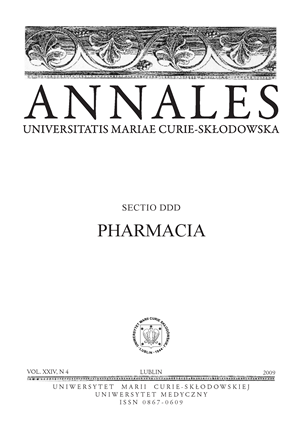Stężenie CETP w surowicy krwi pacjentów po transplantacji nerki
Abstrakt
Białko transportujące estry cholesterolu połączone z cząstką HDL jest modulatorem nie tylko wewnątrznaczyniowego metabolizmu HDL i apoAI, lecz także lipoprotein bogatych w TG i LDL, pośredniczy w transferze estrów cholesterolu z HDL do promiażdżycowych apoB-lipoprotein, i w odwrotnym kierunku – TG głównie z VLDL do HDL. Badania były wykonane u 42 pacjentów po transplantacji nerki (Tx) (kobiety, n=20 i mężczyźni n=22) w wieku 21–60 lat. Badani pacjenci otrzymywali cyklosporynę A + prednison (n=28), tacrolimus + prednison (n=11) i sirolimus + prednison (n=3). Pacjenci z nadciśnieniem, hipercholesterolemią i hipertriglyceridemią leczeni byli fibratami i atorwastatyną albo simwastatyną oraz lekami obniżającymi ciśnienie krwi. Czterdzieści pięć zdrowych osób stanowiło grupę referencyjną (22 kobiety i 23 mężczyzn) w wieku 22–60 lat. Pacjenci po transplantacji nerki byli podzieleni na dwie grupy: TG>150mg/dl i TG<150mg/dl, gdzie stężenie TG 150 mg/dl było kryterium podziału. Celem badań było oznaczenie profilu lipidów, lipoprotein, wskaźników lipidowych i lipoproteinowych, stężenia CETP i BMI u pacjentów po transplantacji nerki z TG>150mg/dl i TG<150mg/dl. Tx pacjenci z TG>150mg/dl mieli istotnie podwyższone stężenia TG, TC, nonHDL-C i wartości wskaźników lipidowych (TC/HDL-C, TG/HDL-C), natomiast znamiennie obniżone wartości wskaźników lipoproteinowych (apoAI/apoB, HDL-C/apoAI) w porównaniu z grupą pacjentów z TG<150mg/dl. Jednakże oznaczane stężenia lipidów (TG, TC, LDL-C nonHDL-C, HDL-C) i wartości wskaźników lipidowych (TC/HDL-C, LDL-C/HDL-C, TG/HDL-C) oraz stężenia lipoprotein (apoAI, apoB) i wskaźników lipoproteinowych 158 E. Kimak, M. Hałabiś, I. Baranowicz-Gąszczyk (apoAI/apoB, HDL-C/apoAI) w obu grupach były istotnie zaburzone w porównaniu ze zdrowymi osobami. Natomiast stężenia CETP w obu badanych grupach były podobne i nie różniły się istotnie statystycznie w stosunku do grupy referencyjnej. Na podstawie badań stwierdzono, że pacjenci po transplantacji nerki z hipertriglyceridemią leczeni statynami i lekami immunosupresyjnymi wykazują tendencje wykluczające udział CETP w patogenezie dyslipidemii, jednak dalsze badania powinny być prowadzone.
Bibliografia
1. Boekholdt S. M., Sacks F. M., Jukema J. W. et al.: Cholesteryl ester transfer protein Taq1B variant, high-density lipoprotein cholesterol levels, cardiovascular risk, and efficacy of provastatin treatment: individual levels patients meta-analysis of 13.677 subjects. Circulation, 111, 278, 2005.
2. Chapman M. J., Goff W., Guerin M., Kontush A.: Cholesteryl ester transfer protein: at the heart of the action of lipid-modulating therapy with statins, fibrates, niacin, and cholesteryl ester transfer protein inhibitors. European Heart Journal, 10, 3, 2009.
3. Chapman M.J.: Therapeutic elevation of HDL-C to prevent atherosclerosis and coronary heart disease. Pharmacol. Ther., 111, 893, 2006.
4. de Vries R., Perton F. G., Dallina-Thie G. M. et al.: Plasma cholesteryl ester transfer is a determinant of intima-media thickness in type 2 diabetic and nondiabetic subjects : role of CETP and triglycerides. Diabetes, 54, 3554, 2005.
5. de Vries-van der Weil J., Zadelaar S., Toet K. et al.: Human CETP aggravates atherosclerosis by increasing HDL-cholesterol in APOE*3-Leiden mice. 206, 153, 2009.
6. Do H.Q., Nazih H., Luc G., Arvei ler D. et al.: Influence of cholesteryl ester transfer protein, peroxisome proliferator-activated receptor, apolipoprotein E, and apolipoprotein AI polymorphism on high-density lipoprotein cholesterol, apolipoprotein A-I, lipoprotein A-I, and lipoprotein A-I:A-II concentrations: the Prospective Epidemiological Study of Myocardial Infarction study. Metab. Clin. and Exp., 58, 283, 2009.
7. Fellstrom B., Holdaas H., Jardine A.: Cardiovascular Disease in Renal Transplantation: Management by Statins. Transplant. Rev., 18, 122, 2004.
8. Friedewald W.T., Levy R. I., Friedrickson D. S.: Estimation of the concentration of lowdensity lipoprotein cholesterol in plasma without the use of the preparative ultracentrifuge. Clin. Chem., 18, 499, 1972.
9. K/DOQI Clinical Practice Guidelines for Chronic Kidney Disease: Evaluation, Classification, and Stratification. Am. J. Kidney Dis., 39, supl. 1, 1, 2002.
10. Kasiske B. L., Cakkera H. A., Roel J.: Explained and unexplained ischemic heart disease risk after renal transplantation. J. Am. Soc. Nephrol., 11, 1735, 2000.
11. Kimak E., Hałabiś M.: Serum hypertriglyceridemia as an important risk factor of chronić allograft failure in post-renal transplant patients. Annales UMCS, Sectio DDD, vol. XXII, 115, 2009.
12. Kimak E., Solski J.: Serum lipid, lipoprotein, leptin, and CETP levels in healthy mem and healthy women. Annales UMCS, Sectio DDD, vol. XXI, 343, 2008.
13. Massy Z. A.: Hyperlipidemia and cardiovascular disease after organ transplantation. Transplantation, 72(s6), 13, 2001.
14. Montanaro D., Gropuzzo M., Tulissi P. et al.: Cardiovascular disease after renal transplantation. G Ital. Nefrol., 21(s26), 53, 2004.
15. Ojo A. O.: Cardiovascular complications after renal transplantation and their prevention. Transplantation, 82, 603, 2006.
16. Pahl M. V., Ni Z., Sepassi L., Moradi H., Vazi ri N. D.: Plasma phospholipid transfer protein, cholesteryl ester transfer protein and lecithin : cholesterol acyltransferase in end-stage renal disease (ESRD). Neprol. Dial. Transplant., 24, 2541, 2009.
17. Salerno A. G., Patricio P. R., Berti J. A., Olivei ra H. C.: Cholesteryl ester transfer protein (CETP) increases postprandial triglyceridemia and delays triacylglycerol plasma clearance in transgenic mice. Biochem. J., 419, 629, 2009.
18. Thompson A., Di Angelantonio E., Sarwar N. et al.: Association of cholesteryl ester transfer protein genotypes with CETP mass and activity, lipid levels, and coronary risk. Jama, 299, 2777, 2008.
19. Tory R., Sachs-Barrable K., Goshko C.B., Hill J. S., Wasan K.M.: Tacrolimus-Induced Elevation in Plasma Triglyceride Concentration after Administration to renal Transplant Patients in Partially Due to a Decrease in Lipoprotein Lipase Activity and Plasma Concentration. Transplantation, 1(88), 62, 2009.
20. Zeller M., Masson D., Farnier M., Lorgis L., Decker t V. et al.: High serum cholesteryl ester transfer rates and small high-density lipoproteins are associated with young age in patients with acute myocardial infarction. J. Am. College Cardiol., 50, 1948, 2007.
21. Zeybek U., Isbi r T., Ergen H. A., Yilaz H., Hekim N., Akoglu E.: Effects of Cholesteryl Ester Transfer Protein TAQ1B Polymorphism in Renal Transplant Patients. Transplant. Proc., 38, 1382, 2006.
Pobrania
Opublikowane
Numer
Dział
Licencja
Prawa autorskie (c) 2009 Autorzy

Praca jest udostępniana na licencji Creative Commons Attribution-NonCommercial-NoDerivatives 3.0 Unported License.


